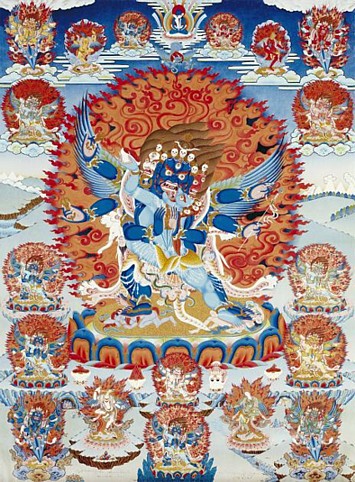Yidam 本尊
跳至導覽
跳至搜尋

Vajrakilaya, a wrathful yidam deity popular in the Nyingma school
Yidam (Tib. ཡི་དམ་, Wyl. yi dam; Skt. iṣṭadevatā) — one of the three roots, the tutelary or chosen meditation deity, which is the root of spiritual accomplishment. Yidams are often classified according to whether they appear in peaceful and wrathful form.
Sogyal Rinpoche writes:
- In Tibetan Buddhism practitioners will have a yidam, that is, a practice of a particular buddha or deity with which they have a strong karmic connection, which for them is an embodiment of the truth, and which they invoke as the heart of their practice. Since in their practice they have recognized the yidam as the natural radiance of the enlightened mind, they are able to view the appearances with this recognition, and let them arise as the deity.[1]
The Importance of Yidam Practice
Orgyen Tobgyal Rinpoche explains the importance of the yidam:
- When we consider all the great masters of the Indian and Tibetan traditions, we find that in every case, their accomplishment came about through their practice of a yidam. They chose a deity and guarded that practice like their very life force, and on the basis of that complete commitment to the path of deity yoga, they practised the stage of generation, the stage of completion, and integrated these arriving at their final realisation of complete accomplishment and enlightenment.
- But nowadays there are people who say, “Oh, what a lot of bother! Deities and mantra, I hate all that. I’m just going to meditate.” And they sit there, and close their eyes, and that’s what they call practice. They say, “I just want to do effortless meditation.” But as Dilgo Khyentse Rinpoche said, “Although there are people like that, I’ve not seen them gaining any sign of attainment.”
- In one of the texts of Ratna Lingpa’s cycle of Vajrakilaya practice, there is a passage which recounts how on one occasion Yeshe Tsogyal asked Guru Rinpoche about the nature of kyérim practice. “Do we really need a yidam deity?”, she questioned. Guru Rinpoche replied, “If there is no yidam, where is the source of siddhis? Without siddhi, how could there be enlightenment?”
- In fact, if we look at the great masters of the Indian and Tibetan traditions of Vajrayana practice, we find there is no-one who did not meditate upon a yidam deity.
- In the Nyingmapa school, all the great vidyadharas have had a main yidam deity which they practised. If their practice was of a peaceful deity, it was almost always Vajrasattva. If it was a wrathful deity, it was almost always Vajrakilaya. Guru Rinpoche and Vimalamitra themselves attested to the fact that Vajrakilaya was their yidam deity.
- Nowadays however, the Nyingmapas are perhaps the worst when it comes to practising a yidam on a daily basis. When Jamyang Khyentse Chökyi Lodrö was giving the Rinchen Terdzö empowerment, he scolded us as Nyingmapa practitioners and said, “You Nyingmapas don’t do any kind of regular daily practice. You don’t even say the Sampa Lhundrupma prayer; you just lie around all day! We Sakyapas must do the path empowerment practice of Hevajra every day , which takes about two or three hours. You don’t do anything. You just lie around. You don’t do any kind of regular practice.”
- He said to us, “If you want yidam deities, you Nyingmapas have more than anybody.” He showed us all the texts of the Rinchen Terdzö, which consists of dozens and dozens of volumes, and said, “This is filled with sadhanas of the three roots—lama, yidam and dakini—but none of you practises any of them.”
- What he said was true. Perhaps the reason is that so many of us in the Nyingma tradition place great emphasis on the Dzogchen tradition and its effortlessness. Often we make the mistake of just paying lip service to effortlessness, while really just being kind of lazy.
- Look at someone like Kyabje Dilgo Khyentse Rinpoche. No-one would question that his realisation was higher than anyone’s, and yet day and night he would recite prayers and mantras and do his practice. And he was inseparable from Vimalamitra! Look at the kind of effort that he put into his practice. Then there are others who just don’t do very much of that at all. They just sit there with their mouths open.
- On one occasion, I asked Dilgo Khyentse Rinpoche, “Is it necessary for someone with realization to recite prayers and mantras?” And he replied, “Someone who has that kind of realisation is like space. What harm could recitation possibly do to space?” And he continued, “To recite even a single mani mantra, or to recite the Vajra Guru mantra a few times, is only going to help. It’s not going to hurt, is it?”
Alternative Translations
- meditational deity (Gyurme Dorje)
- tutelary deity
Notes
- ↑ Sogyal Rinpoche, The Tibetan Book of Living and Dying, page 289.